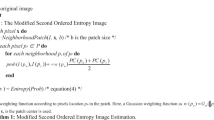Abstract
This paper proposes an efficient method to compute entropy and joint entropy of images. Entropy of images is used to determine its quality. It is defined as the randomness or uncertainty present in the image. Similarly, joint entropy is a measure of the uncertainty present in the overlapped region of two images. Entropy and joint entropy computations are vital in several image processing applications. Intensity based image registration is done by maximizing the mutual information between two images. Mutual information is nothing but the difference between sum of individual entropies and joint entropy of two images. Image registration has applications, especially in the medical field, e.g. diagnosis and treatment of diseases. The entropy and joint entropy computation methods proposed in this paper are computationally less expensive than the standard methods. Entropy computation takes 78.60% less time than the standard method while computational time of joint entropy is reduced by 83.59%. This increase in efficiency comes at the cost of an error of 1.52% in entropy and 4.54% in joint entropy.
Access this chapter
Tax calculation will be finalised at checkout
Purchases are for personal use only
Similar content being viewed by others
References
Amit, Y., Kong, A.: Graphical templates for model registration. IEEE Trans. Pattern Anal. Mach. Intell. 18(3), 225–236 (1996). https://doi.org/10.1109/34.485529
Arun, K., Huang, T., Blostein, S.: Least-squares fitting of two 3-D point sets. IEEE Trans. Pattern Anal. Mach. Intell. PAMI 9(5), 698–700 (1987). https://doi.org/10.1109/tpami.1987.4767965
Besl, P., McKay, N.: A method for registration of 3-D shapes. IEEE Trans. Pattern Anal. Mach. Intell. 14(2), 239–256 (1992). https://doi.org/10.1109/34.121791
Borgefors, G.: Distance transformations in digital images. Comput. Vis., Graph. Image Process. 34(3), 344–371 (1986). https://doi.org/10.1016/s0734-189x(86)80047-0
Chua, C., Jarvis, R.: 3D free-form surface registration and object recognition. Int. J. Comput. Vision 17(1), 77–99 (1996). https://doi.org/10.1007/bf00127819
Collingnon, A., Maes, F., Delaere, D., Vandermeulen, D., Suetens, P., Marchal, G.: Automated multi-modality image registration based on information theory. Inf. Process. Med. Imaging 3, 263–274 (1995)
Elsen, P., Pol, E., Sumanaweera, T., Hemler, P., Napel, S., Adler, J.: Grey value correlation techniques used for automatic matching of CT and MR volume images of the head (1994)
Hajnal, J., Saeed, N., Oatridge, A., Williams, E., Young, I., Bydder, G.: Detection of subtle brain changes using subvoxel registration and subtraction of serial MR images. J. Comput. Assist. Tomogr. 19(5), 677–691 (1995). https://doi.org/10.1097/00004728-199509000-00001
Hill, D., Hawkes, D.: Medical image registration using knowledge of adjacency of anatomical structures. Image Vis. Comput. 12(3), 173–178 (1994). https://doi.org/10.1016/0262-8856(94)90069-8
Hill, D.L.G., Hawkes, D.J., Harrison, N.A., Ruff, C.F.: A strategy for automated multimodality image registration incorporating anatomical knowledge and image characteristics. In: Information Processing in Medical Imaging, pp. 182–196 (1993)
Jiang, H., Robb, R., Tainter, K.: New approach to 3-D registration of multi-modality medical images by surface matching. Vis. Biomed. Comput. 1808 (1992)
Lemieux, L., Kitchen, N., Hughes, S., Thomas, D.: Voxel-based localization in frame-based and frameless stereotaxy and its accuracy. Med. Phys. 21(8), 1301–1310 (1994). https://doi.org/10.1118/1.597403
Meyer, C., Leichtman, G., Brunberg, J., Wahl, R., Quint, L.: Simultaneous usage of homologous points, lines, and planes for optimal, 3-D, linear registration of multimodality imaging data. IEEE Trans. Med. Imaging 14(1), 1–11 (1995). https://doi.org/10.1109/42.370397
Pelizzari, C., Chen, G., Spelbring, D., Weichselbaum, R., Chen, C.: Accurate three-dimensional registration of CT, PET, and/or MR images of the brain. J. Comput. Assist. Tomogr. 13(1), 20–26 (1989). https://doi.org/10.1097/00004728-198901000-00004
Studholme, C., Derek, L., David, J.: Multiresolution voxel similarity measures for MR-PET registration. Inf. Process. Med. Imaging 3, 287–298 (1995)
Studholme, C., Hill, D., Hawkes, D.: Automated 3-D registration of MR and CT images of the head. Med. Image Anal. 1(2), 163–175 (1996). https://doi.org/10.1016/s1361-8415(96)80011-9
Studholme, C., Hill, D., Hawkes, D.: Automated three-dimensional registration of magnetic resonance and positron emission tomography brain images by multiresolution optimization of voxel similarity measures. Med. Phys. 24(1), 25–35 (1997). https://doi.org/10.1118/1.598130
Studholme, C., Hill, D., Hawkes, D.: An overlap invariant entropy measure of 3D medical image alignment. Pattern Recogn. 32(1), 71–86 (1999). https://doi.org/10.1016/s0031-3203(98)00091-0
Thirion, J.: New feature points based on geometric invariants for 3D image registration. Int. J. Comput. Vision 18(2), 121–137 (1996). https://doi.org/10.1007/bf00054999
Wells, W., Viola, P., Atsumi, H., Nakajima, S., Kikinis, R.: Multi-modal volume registration by maximization of mutual information. Med. Image Anal. 1(1), 35–51 (1996). https://doi.org/10.1016/s1361-8415(01)80004-9
Woods, R., Cherry, S., Mazziotta, J.: Rapid automated algorithm for aligning and reslicing PET images. J. Comput. Assist. Tomogr. 16(4), 620–633 (1992). https://doi.org/10.1097/00004728-199207000-00024
Woods, R., Mazziotta, J., Cherry, A.R.: MRI-PET registration with automated algorithm. J. Comput. Assist. Tomogr. 17(4), 536–546 (1993). https://doi.org/10.1097/00004728-199307000-00004
Author information
Authors and Affiliations
Corresponding author
Editor information
Editors and Affiliations
Rights and permissions
Copyright information
© 2020 Springer Nature Switzerland AG
About this paper
Cite this paper
Sengupta, D., Gupta, P., Biswas, A. (2020). An Efficient Method for Computation of Entropy and Joint Entropy of Images. In: Huang, DS., Bevilacqua, V., Hussain, A. (eds) Intelligent Computing Theories and Application. ICIC 2020. Lecture Notes in Computer Science(), vol 12463. Springer, Cham. https://doi.org/10.1007/978-3-030-60799-9_24
Download citation
DOI: https://doi.org/10.1007/978-3-030-60799-9_24
Published:
Publisher Name: Springer, Cham
Print ISBN: 978-3-030-60798-2
Online ISBN: 978-3-030-60799-9
eBook Packages: Computer ScienceComputer Science (R0)




